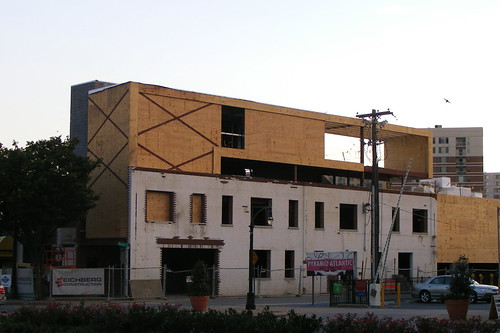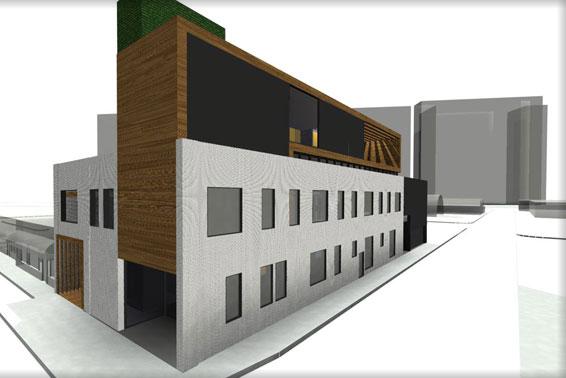
Seeing the renovation underway last weekend, I'm cautiously optimistic about what'll take its place. The new building will serve as headquarters for ALC, a translation company currently based in Rockville, with retail shops lining Georgia and Ripley. Designed by D.C.-based firm Division 1 Architects and being built by Eichberg Construction - responsible for the well-received renovation of the Pershing Court offices on Cedar Street - it mixes new and old in a way that doesn't feel as crass as other remodels in Downtown Silver Spring.

Previously, the answer for older buildings with new uses was to hide the history. The NTB store on East-West Highway just covered up the old façade, though you can see the original roofline sticking out. The Hale Center at Colesville and Ramsey got what Richard Layman calls "metal googaw things" stuck to the outside, which look neither convincing nor attractive.
 But the new ALC building isn't trying to put lipstick on the pig. It's keeping part of the building's original façade, except instead of being the background, it comes out front, serving as the screen for a starkly modern interior. Division 1's website alludes to that tension, saying the "design offers a refreshingly modern face along the aging Georgia Avenue streetscape." Additions to the rear and on top of the building seem to slide behind the old facade, creating a visual conflict between new and old.
But the new ALC building isn't trying to put lipstick on the pig. It's keeping part of the building's original façade, except instead of being the background, it comes out front, serving as the screen for a starkly modern interior. Division 1's website alludes to that tension, saying the "design offers a refreshingly modern face along the aging Georgia Avenue streetscape." Additions to the rear and on top of the building seem to slide behind the old facade, creating a visual conflict between new and old. Along Ripley Street, a thin horizontal band of glass between the second and third floors makes it appear like the addition is floating. (When I saw it, the first thing that came to mind was the Ontario College of Art and Design in Toronto, in which a four-story addition literally hovers above the rest of the school.) On top of it all is an observation deck and sod roof terrace that cascades into the building itself.
Along Ripley Street, a thin horizontal band of glass between the second and third floors makes it appear like the addition is floating. (When I saw it, the first thing that came to mind was the Ontario College of Art and Design in Toronto, in which a four-story addition literally hovers above the rest of the school.) On top of it all is an observation deck and sod roof terrace that cascades into the building itself.These renderings leave a lot of questions about the final product unanswered, like what materials will be used and how it'll relate to the surroundings when completed. It's exciting to see modern architecture in Downtown Silver Spring, but new buildings have a responsibility to the urban context, sharing the spotlight with those who came before.
For more photos of the ALC building and others under construction in DTSS, check out this photoset.

4 comments:
That NTB bulding used to be a Coca-Cola bottling plant. I believe you can still see the Coca-Cola logo in parts, though they've attempted to cover it up.
People are honestly upset that the old pawn shop building is being renovated? Myself, I'm happy to see renovation working its way down Georgia Avenue.
I'm so glad you showed that picture of the new Montgomery College Performing Arts Center. They RUINED a fantastic building by putting that scrolling marquee on it. How freaking tacky...I bet the architect is still shaking his/her head side-to-side in dissapointment.
Speaking of metal googaws, the whole "strap a metal googaw on it" is the worst trend in "architecture" in the past twenty years, and unfortunately is used in new construction as well as in "updating" old buildings. One example that comes to mind is a building in downtown Bethesda that looks like it has the outline of a tomato pinned onto it up by its roofline.
Please help me understand: where the heck does it come from? I can't imagine any respectable architects or architecture schools are encouraging this. Is there some actual design concept they are shooting for?
Post a Comment